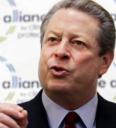– A while ago, I wrote a piece about the World Scientists Warning to Humanity 1992.  Now, DotEarth has come up with a similar warning dating back to 1979 which I’ve copied and linked to, below.
– And for those of you who can date your music impressions way back to the 1960’s, how about “Spirit – Twelve Dreams of Dr. Sardonicus – Nature’s Way“.  Even back then, I could hear what they were saying: “It’s nature’s way of telling you; dying trees.”
– It’s not like the writing about the environment hasn’t been on the wall for those who were looking.
– – – – – – – – – – – – –
The Cassandra Files: A 1979 Climate Warning
Few things are sadder than looking back and contemplating “what might have been.” It’s certainly not the kind of thing most people want to do at a birthday party.
But that was what happened on Oct. 24 when the Woods Hole Research Center in Woods Hole, Mass., marked the 80th birthday of its founder, the biologist and ecologist George Woodwell, with a symposium on “Ecology and the Public Good.”
One participant, James Gustave Speth, passed out copies of a report he received in July 1979, when he was chairman of the White House Council on Environmental Quality. Its title was “The Carbon Dioxide Problem: Implications for Policy in the Management of Energy and Other Resources.” Its lead author was Dr. Woodwell, then the director of the Ecosystems Center at the Marine Biological Laboratory. His coauthors were Gordon J. MacDonald, Roger Revelle and Charles D. Keeling. All were eminent; Dr. Keeling was the first to chart increased concentrations of carbon dioxide in the atmosphere — a rise known today as the Keeling curve. (Click here to download a PDF of the report.)
The report starts off with a blunt warning: “Man is setting in motion a series of events that seem certain to cause a significant warming of world climates over the next decades unless mitigating steps are taken immediately.” It adds, “ Enlightened policies in the management of fossil fuels and forests can delay or avoid these changes, but the time for implementing the policies is fast passing.”
In a forward he wrote for the reprinted report, Mr. Speth, now the dean of the Yale School of Forestry and Environmental Science, tells how the group of scientists prepared it for the White House, and how the Carter administration asked the National Academy of Sciences for guidance on its grim conclusions. While factors like the possible climate buffering influence of the oceans are imperfectly understood, the academy panel said, “if carbon dioxide continues to increase, the study group finds no reason to doubt that climate changes will result and no reason to believe that these changes will be negligible.”
More… ➡
– Thanks to Dot Earth
– This article is from the NY Times and they insist that folks have an ID and a PW in order to read their stuff. You can get these for free just by signing up. However, a friend of mine suggests the website bugmenot.com ![]() as an alternative to having to do these annoying sign ups. Check it out. Thx Bruce S. for the tip.
as an alternative to having to do these annoying sign ups. Check it out. Thx Bruce S. for the tip.



